Delmarva_Struct
Structural
I am trying to design foundations for a building addition for an exiting building. The columns that are near the existing building experience high seismic loads as they form a part of the SFRS of the new building structure. The footings for these columns will have highly eccentric (in both directions) large column loading wherein the column is placed at the corner of a footing. Also we have irregular shaped footings to accommodate the existing footings, utilities etc. I have tried to used strap footings, combined footings etc up to the extent that software's like ENERCALC, ASDIP etc. will allow but they do not work..Does anyone have any recommendations for an FEM software for the analysis and design of highly irregular shaped footings with multiple eccentric loadings?


